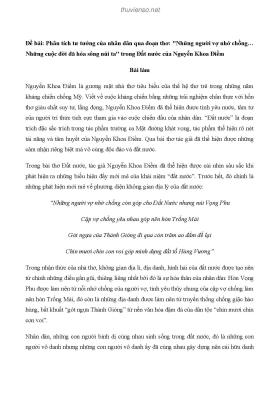Thông tin tài liệu:
Loạt bài này cung cấp một phạm vi bảo hiểm toàn diện các kỹ thuật phân tích được sử dụng để đo các chất trong nước, từ lấy mẫu đến phòng thí nghiệm phân tích. Phạm vi của loạt bài này bao gồm các vấn đề chủ đề bao gồm đảm bảo chất lượng, thủ tục, tiêu chuẩn, và thực hành tốt nhất trong việc đo lường chất lượng nước, từ bề mặt và nước uống ven biển và nước thải....
Nội dung trích xuất từ tài liệu:
Wiley wastewater quality monitoring and treatment_6
JWBK117-1.6 JWBK117-Quevauviller October 10, 2006 20:14 Char Count= 0
Reference Materials
100
Materials and Measurements, IRMM), the certification committee is composed of
representatives from EU countries and Associated States, covering a wide field of
expertise in chemical, biological and physical measurement sectors.
Another approach that is being used for the certification of RMs is actually based
on the voluntary participation of expert laboratories in interlaboratory schemes (e.g.
proficiency testing), using various analytical methods applied by different labora-
tories (Ihnat, 1997). This approach is less prone to control and there are generally
no technical discussions of the results but rather robust statistics to detect and re-
move possible outliers (e.g. based on z-scores). This type of study is certainly useful
for evaluating the performance of laboratories/methods but is not generally recom-
mended for certification unless highly skilled laboratories are involved.
1.6.8.2 Assigned Values
With respect to not-certified materials, there is an interest to obtain good reference
values (assigned values). The same approach and rules as the ones used for certi-
fication to, in principle, needed to obtain good assigned values. A high degree of
accuracy for these values is rarely mandatory for a LRM used for routine quality
control checks (control charts) but it should be attempted for each RM that is used in
method performance studies. Assigned values may be established through measure-
ments carried out in the framework of interlaboratory studies involving experienced
laboratories (they hence correspond to ‘consensus’ values), which is very similar
indeed to the approach followed for certification. The main difference between a
good assigned value and a certified value is actually linked to the (legally binding)
guarantee given by the producer (certificate of analysis) and the procedure used to
obtain this guarantee.
1.6.9 TRACEABILITY OF REFERENCE MATERIALS
Traceability is defined as a property of a measurement or the value of a standard
whereby it can be related to stated references, usually national or international stan-
dards, through an unbroken chain of comparisons all having stated uncertainties
(ISO, 1993).
CRMs and traceability are closely connected since certified values and their uncer-
tainty should, in principle, be linked to established references. In theory, the certified
value of a CRM should be traceable to the amount of substance of the element or
compound of concern.
The establishment of a ‘hierarchy’ of RMs has been proposed by Pan (1997).
The author pinpointed that it is difficult, if not impossible, to trace all matrix CRMs
to primary RMs, because of matrix effects, the variety of sample composition and
substances, etc. In addition, factors influencing the analytical process (e.g. homo-
geneity of the CRM) have an effect on the certified values (Figure 1.6.6).
JWBK117-1.6 JWBK117-Quevauviller October 10, 2006 20:14 Char Count= 0
Traceability of Reference Materials 101
True value
Global and local
comparability
CRM, PT schemes
accreditation
Internal comparability
International Quality Control, LRM
Appropriate calibration
Measurement of samples
Figure 1.6.6 Traceability hierarchy shows how to achieve results close to the true values
The classification proposed provided the main criteria for establishing a hierarchy
in the traceability chain for CRMs:
r metrological quality of methods used for certifying values of the CRM;
r homogeneity and stability;
r calculation of uncertainty;
r metrological competence and recognition of the producer at the national and/or
international level;
r demonstration of traceability.
Numerous chemical measurements are carried out, for which RMs cannot readily
be prepared owing to their ...
